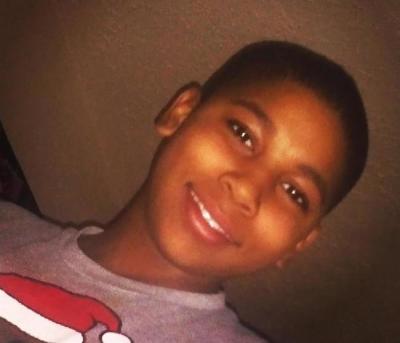A Drive-By Shooting in Cleveland
BY RAJA KRISHNA
The following is based on security footage and audio evidence released to the public by the Cleveland Police Department. Access the video here.
On Saturday, November 22nd, 2014, while the world held its breath in anticipation of the Ferguson grand jury decision, 12-year-old Tamir Rice was kicking at some freshly fallen snow in Cleveland’s West Side. Like many boys his age, Tamir had learned how to entertain himself. Equipped with a toy gun and a child’s imagination, he hung around a gazebo at the Cudell Recreation Center, waving around his fake pistol, inspecting a snow-covered pile of roadside debris, wandering from the grass to the sidewalk and back to grass again, eventually stopping for rest on a bench inside the gazebo.
In the meantime, other patrons of the park were starting to get nervous. They could not tell whether or not Tamir’s gun was real, though the man who eventually called 9-1-1 told the dispatcher multiple times that it was “probably fake.” Following the emergency call, the Cleveland Police Department sent two officers to handle to situation.
While the security footage from the incident does not include audio, is it difficult to imagine that Tamir, still sitting on his park bench, did not hear the police cruiser roaring toward him. He tucked his toy into his waistband, got up from his bench and stepped out from under the gazebo to meet the cruiser, just as it jumped from the road to the curb to the grass and skidded to a stop mere feet from where Tamir was standing.
Even before the police car came to a complete stop, a rookie police officer named Timothy Loehmann threw open the passenger door, stepped outside, drew his gun, and shot the child in the stomach. And so, less than two seconds after the police arrived on the scene, Tamir Rice lay bleeding on the ground, his gut rended by bullet wounds. He died overnight in a hospital.
One thing we know is that the officers dispatched to the scene were never told that the gun might be fake. They may have had a legitimate fear that Tamir Rice was wielding a real pistol. Even so, the officers’ version of events does not align with footage captured by a surveillance camera from across the street. The police claim that Tamir was sitting with a group of people, but the tape clearly shows that he was alone. They claim that they asked the boy to put his hands up three times, but judging by the footage, it is doubtful Loehmann said anything to Tamir before opening fire.
Indeed, it looks like the Cleveland police conducted what amounts to a drive-by shooting of an innocent child.
There are many questions worth asking about the police action that led to Tamir Rice’s death. Why did the dispatcher not inform the police officers that the gun was probably a toy, or that Tamir Rice was a likely a “juvenile,” as the 9-1-1 caller mentioned? Why did the officers pull right up to Tamir instead of parking on the road and assessing the situation? Why did they shoot him on the spot instead of attempting to speak or negotiate with him? Why did they wait for so long to administer any first aid to the child? The list goes on.
But one question weighs most heavily on my mind: would Tamir Rice still be alive if he were white? Would the officers have taken a moment to consider his boyhood? Would they have allowed for the possibility that Tamir, playing with a toy gun, was engaging in an innocent and quintessentially American childhood activity? Would they have tried to talk to him, asked him gently to put his gun down?
Hopefully by now it is no surprise to anyone reading this that police officers—and figures of authority everywhere—carry racial biases with them. But it is especially disturbing to see those biases applied to an innocent child (Tamir had a clean juvenile record). This writer travelled straight from the pained streets of St. Louis to the frost-tipped city of Cleveland to find that the story of trigger-happy, racially biased police officers is dishearteningly ubiquitous.
To readers fighting for justice in the streets of Ferguson, New York, London, or any of the hundreds of other cities lamenting the loss of Michael Brown and the exoneration of Darren Wilson—let Tamir’s story add fuel to your passion.
To readers wondering whether Michael Brown’s case, full of murky plot holes and conflicting accounts, is really the right one to spark a worldwide movement around ending police brutality and systematic oppression of non-whites—if it helps, think about Tamir Rice. Tamir did not rob a convenience store. Tamir did not mouth off to a police officer. Tamir was not high. But Tamir was still gunned down in broad daylight by a pair of cops for playing with a toy gun without even being given a chance to speak.
And please, do call him Tamir. We use last names for adults.
